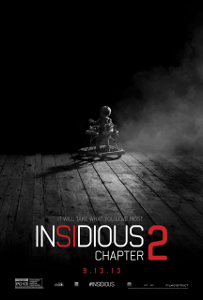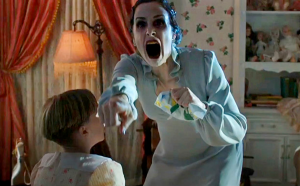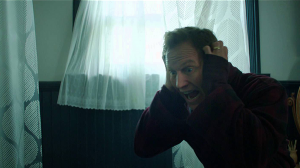 Warning: this review contains spoilers. There’s a big issue I need to discuss and the only way to get at it and how it embodies the biggest flaw of Insidious: Chapter 2 is to discuss one of the major reveals of the film.
Warning: this review contains spoilers. There’s a big issue I need to discuss and the only way to get at it and how it embodies the biggest flaw of Insidious: Chapter 2 is to discuss one of the major reveals of the film.
Insidious: Chapter 2 is a mess. It’s a scary mess that will have you jumping out of your seat, but it’s a mess nonetheless. James Wan and Leigh Whannell (writer/director and writer/star, respectively) left the door wide open for a sequel in Insidious. The story could continue and use a lot of the same scare techniques. The ideas are there to make it work in the sequel, but they really don’t add up in a believable or even enjoyable way.
The Lambert family is still being haunted after they recovered their son from “The Further”–a dark afterlife where trapped spirits wait for their chance to return to the world of the living. Now Josh, the father, isn’t acting like himself and Lorraine, his mother, reaches out to the experts who helped her 30 years before to save the family.
There are no sacred cows in true horror. You can write and direct whatever you want to so long as it services the story you’re telling and scares the audience. Insidious: Chapter 2 doesn’t clear either threshold with it’s worst, most offensive story element.
One of the major ghosts in the story (really, in the series so far) is revealed to be a trans woman. That, in and of itself, is not a problem. It’s the backstory Wan and Whannell attribute to the character that borderlines on the offensive. The character is dead because she attempted to castrate herself and died of complications in the hospital. That’s sad and could have been used as a way to develop anger toward the world in the afterlife if not specifically anger toward the Lambert clan. It could have made for some interesting story dynamics about identity.

A terrible mother cliche in horror or a harmful transphobic stereotype? You decide. [click for full]
Though there is an element of horror in this concept, it’s driven by harmful stereotypes about transgender identity. There are people who perpetuate the myth that something causes a person to choose to be transgender the same way there are people who argue that homosexuality is a choice. These people often cite trauma–things as banal as a boy playing with dolls or a girl playing with trucks–as the cause of not identifying as the sex you were born as. If you read a news story with comments on a transgender child facing problems in a school or extracurricular activity, you’ll see many comments from people claiming the parents must be forcing this alternate identity on the child and should be punished for child abuse.
When the creators of a film that will be seen by as many people as Insidious: Chapter 2 choose to hinge their story on harmful stereotypes, they’re reinforcing stereotypes that hurt the progress we as a society make towards being more tolerant. This is not a device like Norman Bates assuming the identity of his mother to commit his murders; this is a case of choosing to claim a ghost is evil because she was forced by her mother through child abuse to become a woman. It’s a disgusting narrative decision that is entirely laughable in the context of the film. The scenes are so overplayed and filled with such ridiculous melodramatic music stings that it comes across as unintended self-parody. With all the dropped plot threads and incoherent world building that undermines most of the goodwill from Insidious, the last thing Wan and Whannell should have concerned themselves with was explaining why being transgender makes a ghost the villain of a story.
This insensitivity toward a hotly debated sociomedical issue acts a microcosm of the flaws of Insidious: Chapter 2. The story’s focus is entirely misplaced. The investigation with Lorraine Lambert and the surviving partners of paranormal investigator/medium Elise is terrifying but only exists to set the groundwork for the absurd “she’s transgender because of childhood trauma and THAT’s why she’s evil” scene.
Meanwhile, poor Renai Lambert and her three children are fighting a losing battle against the growing evil and insanity wrought by this spirit in their new home. Josh goes from zero to Jack Nicholson in The Shining at the drop of a hat with no explanation beyond “that ghost is evil because she became transgender due to childhood trauma.” Nothing relevant to the minimal story of Chapter 2 is explained in the context of Chapter 2 beyond why the transgender ghost is evil due to childhood trauma.Instead, we get a rehash of Insidious, where Wan and Whannell prove how clever they are by recontextualizing all of the events of the first film through the lens of the second. That’s great for a featurette connecting films in a series on a promotional home video release. It doesn’t work when that’s the most compelling aspect of a new/continuing story with the same characters. It’s like warmed up leftovers that already started to turn. There was, at some point, a good reason to know why the alarm system went off in the first film; that time is not in the middle of a new story that doesn’t even use the same premise or cast of supernatural characters any longer.
Insidious: Chapter 2 has all of its priorities in the wrong place. Instead of focusing on the arguably offensive backstory of a minor villain in a haunted house story, Wan and Whannel should have focused on plot, character development, and the quality of dialogue/performances appearing onscreen. All of that is subpar. It’s all the more obvious when the powerful effect of the ghost design and existing mythology carries any and all horror gags. The only new ideas in Chapter 2 range from completely idiotic to totally offensive and no one walks away a winner from that.
Rating: 3/10
Thoughts? Share them below.

